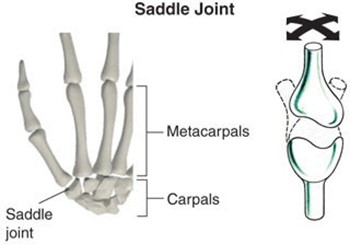What type of joint is present within the thumb?
Hinge.
Condylar.
Saddle.
Ball and Socket.
The Correct Answer is C
The thumb has three joints: the carpometacarpal (CMC) joint, the metacarpophalangeal (MP) joint, and the interphalangeal (IP) joint.
The CMC joint is a saddle type of joint that allows the thumb to move in multiple directions. A saddle joint has two concave surfaces that fit together like a rider on a horse.

Choice A is incorrect because hinge joints allow only flexion and extension movements, such as the IP joints of the thumb.
Choice B is incorrect because condylar joints have an oval-shaped surface that articulates with a shallow cavity, such as the MP joint of the thumb.
Choice D is incorrect because ball and socket joints have a spherical head that fits into a cup-like socket, such as the shoulder or hip joints.
Nursing Test Bank
Naxlex Comprehensive Predictor Exams
Related Questions
Correct Answer is ["Foramen transversarium"]
Explanation

The foramen transversarium is a canal that is found in the transverse process of the cervical vertebrae, C1 through C7.
It is an opening in the bone that allows the passage of the vertebral artery, vertebral vein, and sympathetic nerves.
The vertebral artery passes through the foramen transversarium in C1-C6 vertebrae, while the vertebral vein passes through the foramen in C1-C7 vertebrae.
The sympathetic nerves pass through the foramen in C1-C6 vertebrae as well.
Injuries to the foramen transversarium can cause damage to the vertebral artery and vein, leading to a variety of symptoms, including dizziness, headaches, and visual disturbances.
Correct Answer is D
Explanation
The transverse foramina are openings in the transverse processes of the cervical vertebrae that allow the passage of the vertebral arteries and veins.
They are not found on any other vertebrae.

Choice A is incorrect because spinous processes are bony projections on the posterior aspect of all vertebrae that serve as attachment sites for muscles and ligaments.
Choice B is incorrect because transverse processes are lateral projections on all vertebrae that serve as attachment sites for muscles and ribs.
Choice C is incorrect because costal facets are articular surfaces on the thoracic vertebrae that articulate with the heads of the ribs.
They are found on all thoracic vertebrae except T11 and T123.
Whether you are a student looking to ace your exams or a practicing nurse seeking to enhance your expertise , our nursing education contents will empower you with the confidence and competence to make a difference in the lives of patients and become a respected leader in the healthcare field.
Visit Naxlex, invest in your future and unlock endless possibilities with our unparalleled nursing education contents today
Report Wrong Answer on the Current Question
Do you disagree with the answer? If yes, what is your expected answer? Explain.
Kindly be descriptive with the issue you are facing.
